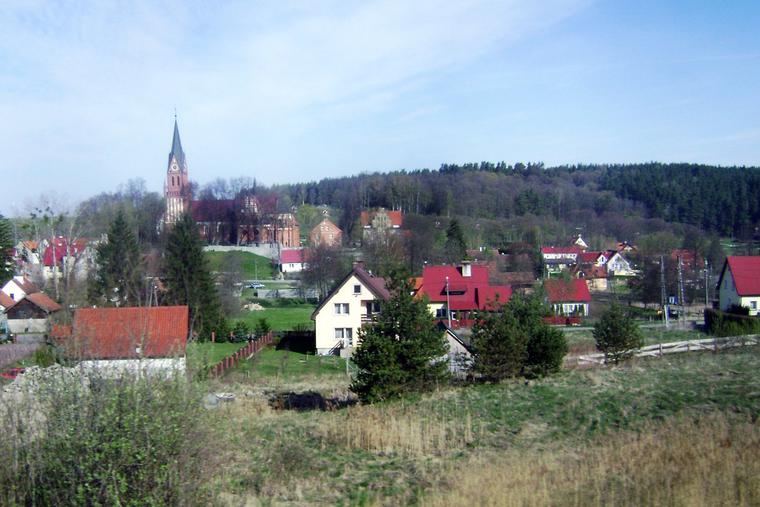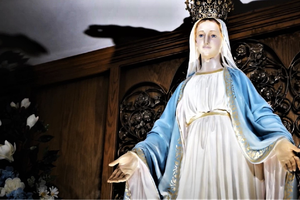40 Years Before Fatima, Our Lady Appeared in Poland
Cardinal Karol Wojtyła presided over the formal approval of the apparition in 1977, shortly before he became Pope John Paul II.

The shrine of the Mother of God of Gietrzwałd (GIETCH-vald) is about 135 miles north of Warsaw. It marks the one site in Poland where the Church has approved an apparition of the Blessed Virgin Mary.
Our Lady appeared in Gietrzwałd from June 27 to Sept. 16, 1877. Two Polish peasant girls testified to seeing her: 13-year-old Justyna Szafryńska, coming home from her pre-Communion examination and, three days later, 12-year-old Barbara Samulowska, while praying the Rosary. Samulowska experienced her vision at the foot of a maple tree in front of the church. She described Our Lady as seated on a throne among angels, with Jesus on her knee. When Samulowska asked who she was, she replied: “I am the Most Blessed Virgin Mary, the Immaculate Conception.” Asked what she demanded of them Our Lady replied that they pray the Rosary daily. Among other questions were two: “Whether the Church in the Kingdom of Poland would be freed and orphaned parishes in southern Warmia would have priests again?” Our Lady replied that, if people prayed fervently, the Church would not be persecuted and those parishes would regain priests.
Those last two questions refer to the pastoral conditions that existed in 1877. In 1877, there was no such thing as “Poland” except in its peoples’ hearts. In 1877, this little town was called “Dietrichswalde.” It was part of Prussia and lay near the border of the “Kingdom of Poland,” which was simply the title applied to an administrative unit of the Russian Empire, devoid of any sovereignty. Prussia and Russia, together with Austria, had collectively gobbled up swaths of Poland’s territory between 82 and 103 years earlier; a resurrected Poland would not appear on Europe’s maps for another 41 years.
Catholics in Poland lived most freely in the Austrian Partition, because the Hapsburgs were Catholics — even if they wanted to subjugate the Church to their state. Orthodox Russia generally persecuted Catholics, and this was especially the case in Poland after the failed 1863 Uprising against Muscovite rule. Otto von Bismarck was in the middle of its own Kulturkampf (1871-1887), intended to subjugate the Church to the Prussian state and to prefer Protestantism.
Our Lady’s responses buoyed the Polish spirit because, even though Poles were politically under foreign dictators, their identity was closely tied up with the Church and the Blessed Mother indicated at least the Church might have enough freedom to function and to have priests.
Pilgrims began to come to Gietrzwałd almost immediately. Because Gietrzwałd was part of a German diocese, local church authorities acted with reserve to the claimed apparitions. The immediate reaction of the German press was that the Gietrzwałd events were politically-charged dangers to the state and the result of Polish religious superstition and fanaticism. Pilgrims and priests were fined. The local bishop, Filip Krementz, undertook an investigation, first through the pastor and then the cathedral chapter, which reported that the visionaries appeared to act sincerely and piously. The events themselves led to a profound religious and Marian renewal in the parish and spread through Prussian and Russian Poland. Father Augustin Wiechsel, pastor of Gietrzwałd for 40 years, promoted the devotion and the religious renewal it engendered, even at the price of many court trials and fines for promoting Marian devotion.
Obviously, the apparitions would also have political consequences. Because Our Lady spoke to the visionaries in the local Polish dialect (so that they could understand) Polish Catholics in Warmia undertook an effort in the mid-1880s to petition Prussian authorities to allow Polish, rather than the obligatory German, to be used in schools.
Formal ecclesiastical approval of the apparitions of Gietrzwałd took place on Sept. 11, 1977, 100 years after the events, by Józef Drzazga, Bishop of Warmia. The celebration was presided over by the Archbishop of Kraków, Karol Wojtyła, who 13 months later would become the Bishop of Rome, John Paul II.
As to the two visionaries, Barbara Samulowska (1865-1950) has a greater significance for Americans. She entered the Congregation of the Sisters of Mercy of St. Vincent de Paul, as she said, according to Our Lady’s wishes, and began her novitiate in 1884 in Paris, in the chapel where Our Lady had revealed the Miraculous Medal. She made her solemn vows in 1889, taking the name Stanisława in religion, and was sent for missionary work to Guatemala. Except for minor interludes in France and Poland, she would spend almost all of the rest of her life working with the poor of Guatemala and Antigua, dying in the former country in 1950. Her process of beatification was concluded on the diocesan level in 2006 and is now in Rome. She is titled “Servant of God.”
While Gietrzwałd is now associated with those Marian apparitions, the cult of Our Lady predated them there by centuries. The image of Our Lady of Gietrzwałd, on the main altar, dates from at least 1583, when Bishop Marcin Kromer described it in his diocesan chronicles as miraculous. Our Lady is depicted in a dark blue gown, holding the Christ Child, dressed in a long red robe, in her left hand. Two angels hold a banner declaring, “Ave Maria Caeolorum, Ave Maria Angelorum.” The figure was first crowned in 1717.
As a result of the 1877 apparitions the Prussian authorities, who were already ill-disposed towards the image, ordered it moved to a less prominent place or even removed. It was eventually located on a side altar in that era, but restored to its place of honor today.
On the final day of Our Lady’s apparitions in 1877, she is said to have blessed a local spring whose waters are regarded as having curative powers for the sick. Of the maple tree in which Our Lady appeared, a cross was made. The Shrine in Gietrzwałd today attracts almost a million pilgrims annually. It was proclaimed a minor basilica by Pope Paul VI in 1970. Live transmissions from the Shrine can be found here.
In the next article, we’ll go to the other end of Poland to visit that was a boyhood pilgrimage site for Karol Wojtyła: Kalwaria Zebrzydowska.














